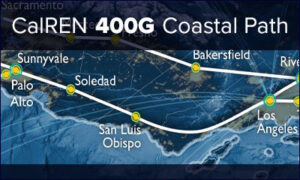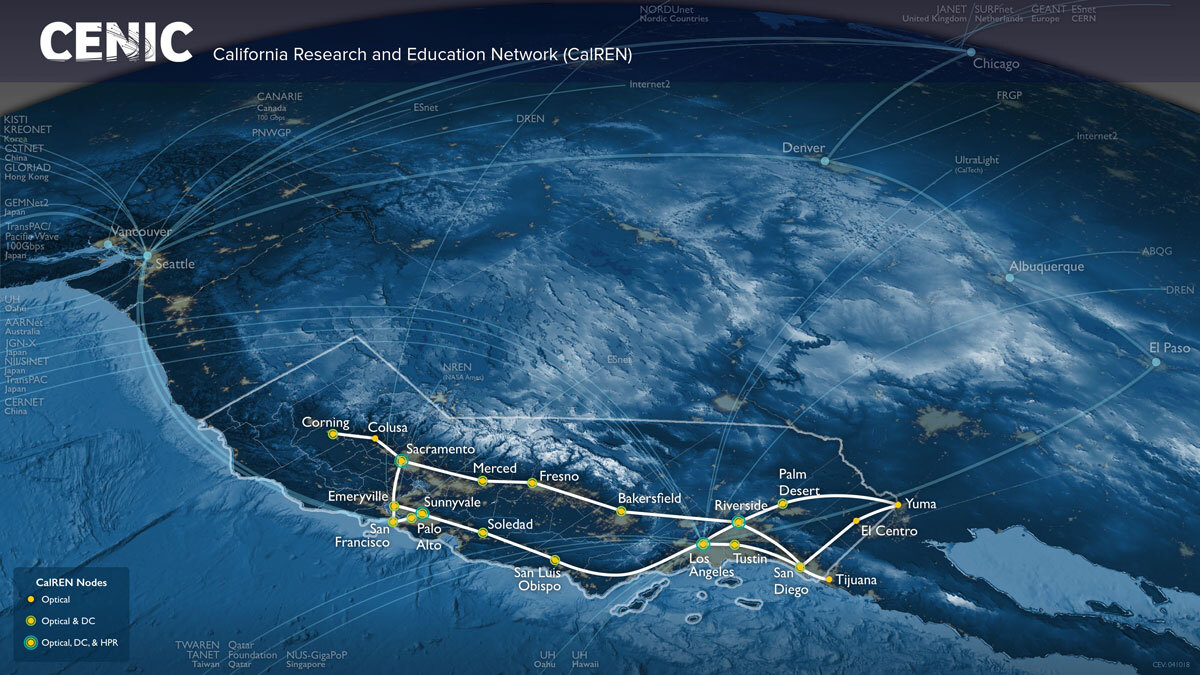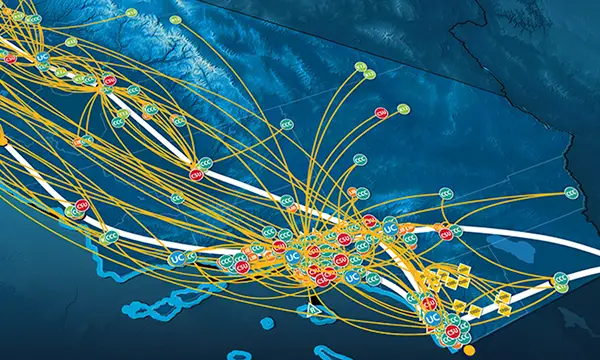- About
- Network
- Community
- Initiatives
- News
- Events
- Blog
- Publications

CENIC Extends 400G Capabilities to Coastal Path Between Los Angeles and Sunnyvale
Categories RENS & NRENS Press Release
Tags California Institute of Technology California State University esnet FABRIC icecube LHC LIGO Naval Postgraduate School pacific research platform San Diego Supercomputer Center science dmz stanford university university of california
La Mirada & Berkeley, Calif., Aug. 7, 2020 — CENIC is now able to provide high-capacity services, from 100G to 400G and beyond, on its coastal path between Los Angeles and Sunnyvale. The research and education network upgraded its optical line system along the 460-mile path, including nodes in Santa Barbara, San Luis Obispo, and Soledad.
CENIC’s California Research and Education Network (CalREN) serves the vast majority of K-20 students, educators, researchers, and individuals at other vital public-serving institutions. CalREN operates over 8,000 miles of fiber optic cable and serves more than 20 million users.
New high-capacity capabilities along the coastal route are part of CENIC’s strategic plan to upgrade its optical network to the latest 400G-plus capable technology. In 2019, CENIC upgraded the southern path of its network between Los Angeles and Riverside, including nodes in Tustin, Oceanside, San Diego, Escondido, and Sun City. Work will start in the fall on upgrades to the final inland path, which completes the network ring from Sunnyvale back to Los Angeles and includes nodes in Oakland, Sacramento, Fergus, Fresno, and Bakersfield.

“Next-generation infrastructure ensures CENIC can easily meet today’s networking demands while remaining flexible to meet the needs of tomorrow,” said CENIC President and CEO Louis Fox. “These upgrades provide CENIC’s members a more robust and efficient network on which to conduct data-intensive research, support teaching and learning, provide cutting-edge medical care, and enhance community engagement.”
To develop the new 400G coastal route, CENIC staff upgraded the existing backbone network from fixed-grid technology to flex-grid spectrum Reconfigurable Optical Add-Drop Multiplexers (ROADMs). Flex grid optimizes the amount of spectrum used per wavelength, enabling more data capacity to be provisioned over fiber spans.
“We no longer have to be restricted to fixed-grid implementations,” said Sana Bellamine, CENIC senior optical engineer. “This new method maximizes the capacity over the fiber, and it enables us to deploy next-generation transponders that can deliver high-capacity services at a lower price per bit.”
New high-capacity services will help address increasingly urgent needs for advanced cyberinfrastructure, especially as supercomputers approach exascale capabilities. Notably, scientific research done by CENIC members such as the University of California, Stanford University, California Institute of Technology, the Naval Postgraduate School, and California State University includes astronomy, genomics, climatology, seismology, and other domains. These researchers require massive big-data workflows, which include collecting, transferring, processing, and storing huge data sets as they collaborate with colleagues at institutions across California, the nation, and the world.
Regionally, CENIC’s high-capacity links will support the Pacific Research Platform (PRP), a partnership of more than 50 institutions, led by researchers at UC San Diego and UC Berkeley, with support from the National Science Foundation. PRP builds on the optical backbone of Pacific Wave, a project of CENIC and Pacific Northwest Gigapop, to create a high-speed freeway for large scientific data sets by connecting campus networks and supercomputing centers on a regional scale, with Science DMZs at each site.
Developed by the US Department of Energy’s Energy Science Network (ESnet) engineers, the Science DMZ model addresses common network performance bottlenecks encountered at research institutions by creating an environment that is tailored to the needs of high-performance science applications, including high-volume bulk data transfer, remote experiment control, and data visualization. PRP’s design supports university researcher data analysis for projects such as the Large Hadron Collider (LHC), the National Science Foundation’s South Pole Neutrino Detector (IceCube), and the Laser Interferometer Gravitational-Wave Observatory (LIGO).
Nationally, CENIC’s high-capacity connections will also support efforts such as FABRIC, an NSF-funded platform for “reimagining the Internet.” FABRIC will provide a nationwide testbed for scientists to explore how data can be stored, computed, and moved through shared infrastructure to build the Internet architecture of the future. FABRIC anticipates a 1 terabit-per-second (Tbps) network, interconnecting nodes at major research and supercomputing centers, including the San Diego Supercomputer Center, and other connections along the West Coast.
Related blog posts
The Big Game Is Big Data: How CENIC and the California Research and Education Network Support Member Athletics
When Fresno State needed to connect to Pac-12 Enterprises to broadcast a live football game over CBS, the Chancellor's Office reached out to CENIC for what Pac-12 later called the smoothest turn-up they've ever experienced.
Enabling Network-Based Collaboration Around the World: A Tour of CENIC and Partner Network Maps
On the Network Maps page at the CENIC website, you’ll find maps of all the networks, peering facilities, and exchanges to which CalREN connects, showing how thousands of CENIC member institutions connect to CalREN and to colleagues all over the globe.


